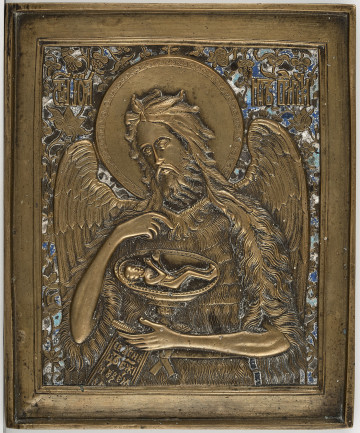
St. John the Baptist
20th century
Castle Museum in Łańcut
Part of the collection: Icons
Nicholas the Wonderworker, the 3rd/4th-century bishop of the city of Myra in Asia Minor, is one of the most venerated saints in Eastern and Western Christianity. He was mentioned in Athanasius's list of attendees of the 325 First Council of Nicaea. In later legends, the story of St. Nicholas's uncompromising attitude towards Arius and his heresy during the council was embellished with abundant details. After the death of the saint, his bios or biography was probably not compiled because during the time of the persecution of Christians, written mentions appeared mainly in relation to the deaths of martyrs and St. Nicholas did not shed blood in defence of faith. He was sometimes identified with the 6th-century monk Nicholas, archimandrite of the monastery of Holy Zion, later bishop of the city of Pinara. The popularisation of the previously little-known in Asia Minor name 'Nicholas', as well as the cult of the saint developing on a large scale in the 5th-6th c., constitute indirect but important evidence of the authenticity of Nicholas of Myra. Encomia - speeches of praise - and temples under the patronage of Nicholas the Wonderworker prove the existence of his cult. Among the oldest and still preserved to this day is the basilica Church of St. Nicholas in Myra, today's Demre, Turkey. The remains of the saint were housed there, in a Roman sarcophagus made of marble. They were moved to the Italian Bari in 1087. The cult of St. Nicholas spread in Rus, where he was counted among the most important intercessors and frequently portrayed, see S.12805MŁ, S.12820MŁ, S.12836MŁ, S.12868MŁ, S,12950MŁ. In icons, St. Nicholas is depicted in both full form and half-figure. The presented painting is especially interesting because of the repainting which is partially damaged and reveals fragments of a 17th c. depiction. Teresa Bagińska-Żurawska https://orcid.org/0000-0002-9243-3967
Dimensions
height: 31.5 cm, width: 25 cm
Object type
Icons
Technique
tempera
Material
tempera, wood
Origin / acquisition method
decyzja administracyjna
Creation time / dating
Creation / finding place
Owner
Castle Museum in Łańcut
Identification number
Location / status

20th century
Castle Museum in Łańcut

19th (?) century
Castle Museum in Łańcut

1800 — 1850
Castle Museum in Łańcut
DISCOVER this TOPIC
Museum of King Jan III's Palace at Wilanów
DISCOVER this PATH
Educational path